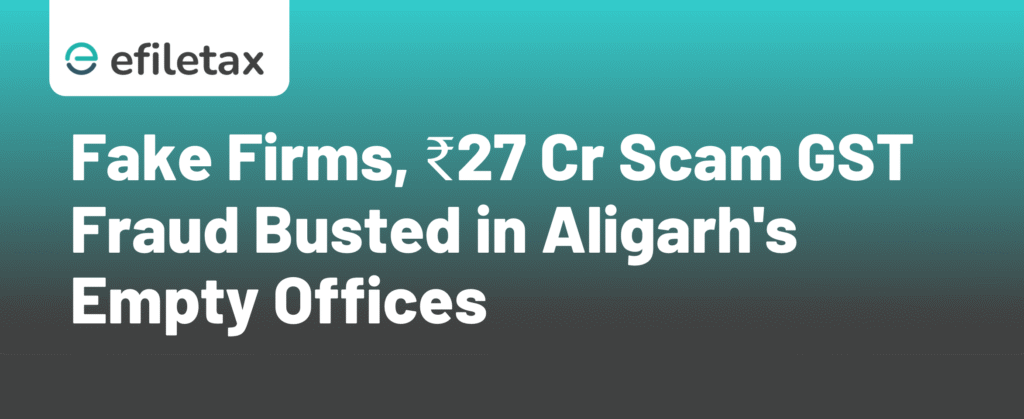
GST Scam in Aligarh: ₹27 Crore Fake Bill Fraud Busted
In a major crackdown on tax fraud, the Directorate General of GST Intelligence (DGGI) has unearthed a ₹27 crore GST scam in Aligarh involving fake invoices, non-existent offices, and shell firms. The case highlights a growing concern over fraudulent input tax credit (ITC) claims using bogus bills.
Let’s break down the case, the law, and what it means for genuine taxpayers.
How the ₹27 Crore GST Scam Was Executed
As per DGGI sources and media reports:
- Over 20 fake firms were created across Aligarh and neighbouring towns.
- These firms existed only on paper, with no actual business operations or physical offices.
- The scamsters generated fake purchase and sales invoices without actual movement of goods.
- This led to fraudulent ITC claims worth ₹27 crore, passed along the supply chain.
- Investigations revealed links to one mastermind operator, who floated multiple firms in the names of unknown persons.
Legal Provisions Involved
Here’s what the law says under the CGST Act, 2017:
| Provision | Key Details |
|---|---|
| Section 132 | Fraudulent ITC claims above ₹5 crore can lead to arrest and imprisonment (up to 5 years). |
| Rule 86A | Allows blocking of ITC if the credit is deemed inadmissible or fraudulent. |
| Section 122 | Prescribes penalty up to ₹10,000 or the amount of tax evaded (whichever is higher). |
CBIC has repeatedly warned businesses about the serious consequences of fake ITC claims, especially when done via shell companies or without real transactions.
What CBIC Is Doing About It
The CBIC and DGGI have intensified audits and data-driven AI surveillance. Here’s what’s happening:
- PAN-linked GSTIN monitoring is being done to track suspicious ITC flows.
- E-way bill mismatches and GSTR-3B vs GSTR-2A discrepancies are under scrutiny.
- Field formations are conducting physical verifications of registered business premises.
🔗 Visit cbic.gov.in for official press releases
Expert Tip: How to Stay Safe from ITC Fraud Exposure
Even genuine taxpayers can get into trouble if they deal with suspicious vendors. Here’s how to protect your business:
- Verify vendor GSTIN on the GST Portal.
- Check if invoices reflect in GSTR-2B before claiming ITC.
- Avoid working with suppliers with no digital footprint or history.
- Conduct periodic vendor KYC and check for any CBIC alerts.
💡 Efiletax Insight: We recommend businesses maintain a robust vendor compliance tracker using GSTR-2B reconciliation tools to detect mismatches early.
What This Scam Means for Honest Taxpayers
The ₹27 crore GST scam in Aligarh is not just about one racket—it reveals how systemic fraud can impact:
- Input credit chains – leading to ITC denial for innocent buyers
- Delayed refunds due to increased scrutiny
- Increased compliance burden through audits and verifications
It’s crucial to adopt best practices and avoid shortcuts in compliance.
FAQ on GST Fake Bill Scams
Q1. What is a fake GST invoice?
A fake GST invoice is one issued without actual supply of goods/services, often to fraudulently claim ITC.
Q2. Can I be penalized for unknowingly claiming fake ITC?
Yes. Even if done unintentionally, Section 16(2) requires actual receipt of goods/services. Claims without proof can be disallowed.
Q3. How can I detect if a supplier is fake?
Check if their GST returns are filed regularly, verify address, and track invoice matching in GSTR-2B.
Summary
GST scam in Aligarh exposed: DGGI busts ₹27 crore fake ITC racket involving bogus firms and fake invoices. Know the legal risks and how businesses can stay compliant.
Final Thoughts
The GST regime is becoming increasingly data-driven and risk-based. Fraudulent practices not only attract strict penalties but also impact genuine businesses linked to fake vendors.